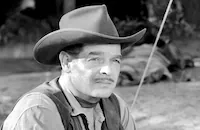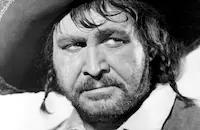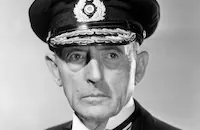The Mummy's Ghost

Brief Synopsis
Cast & Crew
Reginald Leborg
John Carradine
Robert Lowery
Ramsay Ames
Barton Maclane
George Zucco
Film Details
Technical Specs

Synopsis
At the Temple of Arkam in Egypt, Yousef Bey is summoned by the High Priest, who tells him the 3,000 year old story of the forbidden love of Princess Ananka and Kharis, a commoner. At the same time, in a college classroom in Mapleton, Massachusetts, Professor Matthew Norman, an Egyptologist, tells his students how the tomb of Princess Ananka was removed from its burial place and became a prized possession of the Scripps Museum in New York. Norman also tells his students the story of Kharis, who was kept alive in a mummified state through the use of tana leaves and smuggled into the United States. Kharis killed all the members of the Egyptian expedition that uncovered Ananka's tomb, and later perished in a fire. Amina Mansouri, an Egyptian exchange student, is particularly unnerved by Norman's talk, causing her boyfriend, Tom Hervey, much concern. Back in Egypt, Yousef learns that Kharis still lives, and is dispatched to American to return both Ananka and Kharis to their rightful resting places in Arkam. Meanwhile, back in his laboratory, Norman brews nine tana leaves, unaware that their smell is attracting Kharis. As the mummy passes her home, Amina goes into a trance-like state and follows Kharis to the Normans' house. There, Kharis strangles the professor to death, then drinks the life-sustaining tea. While the sheriff quickly surmises that Norman's murder is the work of Kharis, having discovered mold around the professor's neck, he questions Amina about her possible involvement, as she was found unconscious just outside the murder scene. Although Amina has no memory of the night's events, she suddenly develops a gray streak in her hair. Yousef then arrives in Mapleton and revives Kharis during the next full moon. The two go to the Scripps Museum to retrieve the body of Ananka, but she disintegrates when touched by Kharis. At the same time, a frightened Amina awakes with a scream, and Yousef quickly assumes that Ananka's soul has been reincarnated. The next day, Dr. Ayad, the museum's curator, tells Police Inspector Walgreen that the tomb's hieroglyphics prophesy Ananka's reincarnation. The two then go to Mapleton, where, along with the sheriff, they set a trap for Kharis. Meanwhile, Tom proposes to Amina, and they make plans to leave for his family's home in New York the next day. That night, however, Kharis is led by a shaft of light to Amina's home. Awakened by his presence, Amina faints, so Kharis abducts the young woman and takes her to his hiding place, an abandoned mine shaft. Yousef's lust for the beautiful Amina overcomes his priestly duties, and rather than killing the young woman, he attempts to give her immortality using the tana leaves. Kharis realizes his treachery in time, however, and kills the priest. After knocking Tom unconscious, Kharis then carries Amina, who has now been transformed into the decaying Ananka, into the nearby swamp, where the townspeople watch as the two ancient lovers slowly sink into the mire.

Director
Reginald Leborg
Cast

John Carradine

Robert Lowery

Ramsay Ames

Barton Maclane

George Zucco

Frank Reicher
Harry Shannon

Emmett Vogan
Lester Sharpe
Claire Whitney
Oscar O'shea

Lon Chaney [jr.]
Jack C. Smith
Jack Rockwell
Carl Vernell
Stephen Barclay
Dorothy Vaughan
Mira Mckinney

Bess Flowers
Caroline Cooke
Eddy Waller
Ivan Triesault
Anthony Warde
Pietro Sosso

Martha Macvicar
Fay Holderness
Crew
Bernard B. Brown
R. A. Gausman
Joseph Gershenson
Saul Goodkind
John B. Goodman
Abraham Grossman
Griffin Jay
Griffin Jay
Jess Moulin
Jack Pierce
Ben Pivar
H. J. Salter
Melville Shyer
William Sickner
L. R. Smith
Henry Sucher
Henry Sucher
Brenda Weisberg
Vera West

Film Details
Technical Specs

Articles
The Mummy's Ghost
The third and best film in the series is The Mummy's Ghost (1944). Back in Egypt, George Zucco's High Priest dispatches his agent Yousef Bey (John Carradine) to the American town of Mapleton, with the cupid-like mission to reunite the undead mummy Kharis with his lost love Ananka. Kharis was seen to perish in a burning house at the finale of The Mummy's Tomb (1942), yet a professor in Mapleton writes his own death warrant when he experiments with tana leaves. The magic elixir draws Kharis from his hiding place in the woods. Exchange student Amina (Ramsay Ames), a local beauty of Egyptian extraction, has an extrasensory connection to Kharis that causes her to develop a white streak in her hair. The menacing Yousef Bey then arrives to take control of Kharis. They invade a New York museum to transfer Ananka's soul to Amina's body, and then successfully kidnap Amina to complete the process. Falling instantly in love with the woman, Yousef Bey foolishly tries to take Amina for himself. With Amina's boyfriend Tom (Robert Lowery) too late to intervene, Kharis carries Amina into the swamp.
Universal starlet Ramsay Ames reportedly got the assignment when the actress Acquanetta (born Mildred Davenport) fainted on the first day of shooting in August 1943. The reincarnation theme assures that all three leading men--Kharis, Carradine and Lowery --become obsessed with the gorgeous Amina. Critics noticed that by this time the mummy series had run out of ideas. Lon Chaney Jr. has little to do in his elaborate mummy makeup, but it is said that he played the wordless role for every scene, rather than use a stand-in. Writer Tom Weaver reported that Chaney complained about the sweaty costume, which generated day-long itches he couldn't scratch. Chaney would don his bandages one more time for final series installment The Mummy's Curse (1944), which followed just six months later.
Although it was presumably part of the screenplay, director Reginald Le Borg took credit for the film's impressively downbeat finale, in which Ramsay Ames' Amina meets a supernatural fate similar to that of actress Margo in Frank Capra's Lost Horizon (1937). The final chase to rescue Amina in the swamp disturbs when it becomes obvious that the posse will arrive too late. Most every monster movie before and since has ended with the rescue of the kidnapped heroine. The unexpected bleak finish of The Mummy's Ghost makes it the most memorable of the three sequels.
By Glenn Erickson

The Mummy's Ghost
Quotes
Trivia
The early shot of Yousef Bey, played by John Carradine, ascending the stairs to the temple where he will present himself to the aging High Priest Andoheb (George Zucco), is actually footage of Zucco as a much younger Andoheb doing the exact same thing in Mummy's Hand, The (1940).
Notes
According to Hollywood Reporter, actress Acquanetta was originally cast in the role of "Amina Mansouri," but after suffering from fainting spells on the first day of shooting, was replaced by Ramsay Ames. Modern sources, however, state that Acquanetta fell and struck her head on the set and suffered a concussion which required her hospitalization. To prevent any delay in shooting, associate producer Ben Pivar then brought in Universal contract player Ames. In an interview published by modern sources, Acquanetta claimed that non-union crew members placed real rocks on the set, instead of papier-maché ones, and it was on one of those rocks that she struck her head during filming, suffering permanent disabilities. Modern sources include David Bruce (Voice of radio actor) to the cast. The Mummy's Ghost was the fourth film in Universal's "The Mummy" series, and the third to feature the character of "Kharis." It was followed by another 1944 release The Mummy's Curse (see entry above). For additional information on the series, please consult the Series Index and see the entry for The Mummy (see AFI Catalog of Feature Films, 1931-40; F3.2980).















